

Rockets
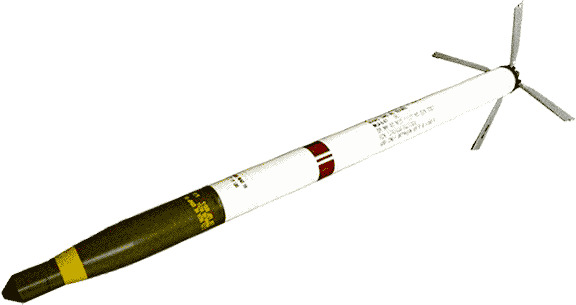 The 2.75 inch Folding Fin Aerial Rocket (FFAR)
The 2.75 inch Folding Fin Aerial Rocket (FFAR)
see Anti- tank
For our UH-1C and Cobra Gunships
see Flechettes - VT (Variable Time) Fuse - 6lb HE - emails 1 - emails 2
.....................................................................................................................................................................................
The 2.75 inch (70mm) folding fin aerial rocket (FFAR) was fired from our UH-1C and AH1G Cobra Gunships.
In the early years the High Explosive (HE) warhead was 10 pounds. As the war progressed, the 17 pound warhead was introduced. It was attached to the same rocket motor and became the weapon of choice.
Maximum range was listed at 8000 meters, but the Centaurs generally fired at 1000 to 1600 meter range for more accuracy.
The rockets were launched from pods of 7, 19 or 24 tubes. There was one pod on each side of the helicopter, matched in size for weight and balance purposes. Rockets were generally fired in pairs for that same reason (one rocket from each side). The pilot could select how many rockets to fire using a control box in the cockpit called an Intervalometer.

The 10lb HE warheads were similar in explosive power to the WWII 75mm howitzer round and having up to a 50 meter casualty radius.
The 17lb HE warheads had similar explosive power to the 105 Howitzer artillery round in their effectiveness.
 We used the 10lb White Phosphorus (WP or "Wily Pete") warhead almost exclusively for marking targets. WP is a highly efficient smoke-producing agent, burning quickly and producing an instant blanket of smoke.
The photo to the right is a pilot showing a comparison of the 10 pound and 17 pound 2.75" folding fin rockets. Introduced sometime in 1968, the new rocket had the same rocket motor as the 10 pound warhead rocket. However, because of the much heavier warhead, the flight characteristics required the use of not only "windage" correction, but super-elevation.
We used the 10lb White Phosphorus (WP or "Wily Pete") warhead almost exclusively for marking targets. WP is a highly efficient smoke-producing agent, burning quickly and producing an instant blanket of smoke.
The photo to the right is a pilot showing a comparison of the 10 pound and 17 pound 2.75" folding fin rockets. Introduced sometime in 1968, the new rocket had the same rocket motor as the 10 pound warhead rocket. However, because of the much heavier warhead, the flight characteristics required the use of not only "windage" correction, but super-elevation.
We used three versions of the 10 pound warhead, High Explosive (HE), White phosphorus (WP) and the Flechette (Nails). Once the newer and more devistating 17 pound warhead came out in mid 1967, we pretty much quit using the 10 pound HE.
Summary:
The 6 pound HE: The MK-4 (shown below) was the very first 2.75 inch rocket and called the Mighty Mouse. It was used in the 1950's on fast movers as an air to air weapon. It was 1.2 m (4 ft), and it weighed 8.4 kg (18.5 lb). Maximum range was around 6000 m (6500 yds), but effective range was more like 3400 m (3700 yds). It was not very common to us. Tom Dooling remembers finding some in Tay Ninh and using them to try to shoot into the caves and tunnels on Nui Ba Den. He says they fired out of the pods like scalded cats - and they went really straight.
MK-4 Mighty Mouse
Rick Chesson 1/9th Cav, (Sabre 14) remembers during late spring of 69 there was a shortage of rockets, with the Cav receiving "6 lb AT" rockets from Germany stock piles. About that time Jeff Ammo plant restarted old rocket production line, and then built a new modern production line.
The 6 lb rockets we received were labeled AT, fuse barely stuck out of rocket pods. They flew straight and quick, worked on bunkers and buildings, but other than that they were lawn darts. Like having a quiver of arrows with no Robinhood.
The 10 pounder HE: M151 High-Explosive. (see diagram below) is an antipersonnel and antimaterial warhead. The bursting radius is 10 meters; however, the high velocity fragments can often increase the lethality radius in excess of 50 meters. The nose section is constructed of cast iron and threaded to receive the fuze. The base section is constructed of steel or cast iron and is threaded so that it can be attached to the rocket motor. The base section and the rocket motor are brazed together. Total weight of the loaded, unfuzed, warhead is 8.7 pounds, of which 2.3 pounds is composition B4 explosive.
The 10 pounder WP: M156 White Phosphorous/Smoke. "Willie Pete" (see diagram below) Primarily used for target marking and incendiary purposes. Similar construction to the HE warhead but contains 2.2 pounds of WP with .12-pound bursting charge of composition B. Weight of the fuzed warhead is about 9.7 pounds.
The 10 pounder Flechette: WDU (4A/A). Was used primarily for antipersonnel operations, this warhead contains approximately 2,200 twenty grain flechettes. The flechettes are released by a base-mounted, fuze-ignited (integral fuze) expulsion charge at rocket motor burnout. Fuzed weight of the flechette is 9.3 pounds.
The 17 pounder HE: M229 High-Explosive. Is an elongated version of the M151. The filler consists of 4.8 pounds of composition B4 explosive and can use the same fuzes as the M151. Its unfuzed weight is 16.4 pounds.
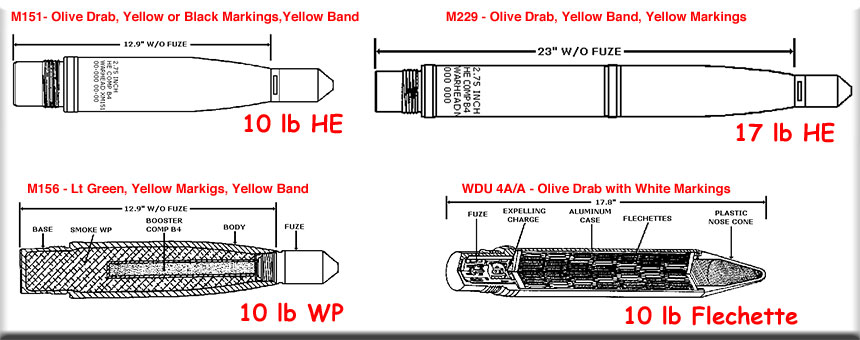
For the 2.75 inch Folding Fin Aerial Rocket
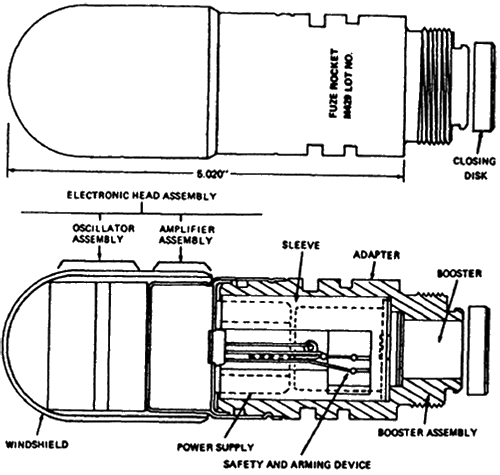 Although we always called them VT - what they actually are is Proximity Fuzes that provided an airburst about 5 meters above the ground.
Although we always called them VT - what they actually are is Proximity Fuzes that provided an airburst about 5 meters above the ground.
Technical Data (TM 43-0001-30): This fuze is an all transistorized, continuous wave, doppler device to provide airburst characteristics. It was designed primarily for use with HE warheads for improved anti-personnel effectiveness. A super-quick impact switch serves as a backup in the event of failure of the airburst electronics. The arming mechanism is similar to that contained in the standard fuse (M423/M427) except that it has been modified to include an electric detonator as well as a battery starter assembly to initiate an electric battery. An electric detonator is assembled in the rotor. A plastic (lexan) sleeve houses the thermal battery which is located directly above the safety and arming device.
See photo one in Sam Dooling's PhotoAlbum
For the 2.75 inch Folding Fin Aerial Rocket
.....................................................................................................................................................................................
The 10 pound Flechette: WDU (4A/A). Was used primarily for antipersonnel operations. Contained approximately 2,200 twenty grain flechettes. The flechettes are released by a base-mounted, fuze-ignited (integral fuze) expulsion charge at rocket motor burnout. Fuzed weight of the flechette is 9.3 pounds.
Additional Rockets used by F Troop 4th Cav
 10 lb MK-5 HEAT (High Explosive Anti-Tank) This was an older warhead we received upon moving to Tan My and encountering NVA armor. It was reportedly unreliable and marginally effective.
10 lb MK-5 HEAT (High Explosive Anti-Tank) This was an older warhead we received upon moving to Tan My and encountering NVA armor. It was reportedly unreliable and marginally effective.
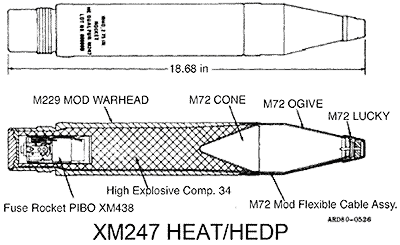 June-July 1972 we received the experimental XM247 dual purpose HEAT/HEDP (High Explosive Dual Purpose) warhead that offered improved armor penetration along with a fragmentation capability for anti-personnel use. The warhead was apparently cobbled together by using the body of the M229 17 lb warhead with components of the M72 LAW. To my knowledge we never had the opportunity to validate it against NVA armor.
June-July 1972 we received the experimental XM247 dual purpose HEAT/HEDP (High Explosive Dual Purpose) warhead that offered improved armor penetration along with a fragmentation capability for anti-personnel use. The warhead was apparently cobbled together by using the body of the M229 17 lb warhead with components of the M72 LAW. To my knowledge we never had the opportunity to validate it against NVA armor.
Email Discussion about Flechettes:
Bruce Powell (67-68):
I haven't yet found the writings that Tom Meeks and I did at Cobra Hall for the gunnery training program that we developed, but the 1600 meter slant range to get a football size impact area with flechettes is a strong memory for me (doesn't mean that it is right. I'll keep looking).
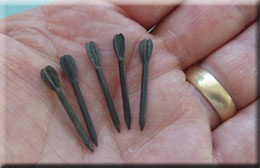 We need to hear from the F Troop guys (71-72) about their use of flechette rounds. I was there in 72 with a different unit (supporting the Korean Army) and flechettes were a basic load for my external Cobra stores.
We need to hear from the F Troop guys (71-72) about their use of flechette rounds. I was there in 72 with a different unit (supporting the Korean Army) and flechettes were a basic load for my external Cobra stores.
Bob Graham (66-67):
The 1600 meter Range
A football field two or three. If that that is is size of area you were suppressing that's the correct range. Our targets were much more selective. For each side of and LZ or a tree line, small canyon, top of a ridge line. So your are right on. We often did not have that much area or room between the slicks and the suppressed area. Our initial. pass was the actual LZ just before the slicks touched down to stick all the little guys before touch down. The following team or second pass of a single team covered the most like prepared positions and the initial objective. Then another team would arrive for this to develop. We put a lot into the initial suppressive fires to insure a successful organization and first movements of the landed force. I did have a slick driver come stomping into my battery with a little arrow between his fingers. All excited about getting it out of his rotor blade. I asked him if it was a hot LZ. He said Yes. I asked how much fire he received, He said, none. There was silence==== then he understood. We had a cold beer.
Pat Eastes (67-68):
I flew guns my whole tour, but I'm damned if I remember ever shooting nails. Tom says we would have used them during Tet 68, but again, I sure don't remember using them. Am I alone with this CRS syndrome, or do other gun drivers not remember using flechettes?
Charlie Johnson (67-68):
I am on the same memory lane as Pat on this one: A dead end.
I flew HOGS from about August 1967 to about May 1968 and don’t recall any flechette rockets being used or tested by the Heavy Weapons Section. Ditto for the Heavy Scouts as far as my recollection goes.
I do recall seeing a flechette round being fired by one of the Cav tanks at the 1968 Ton Son Nhut war games. We were trying to line up a gun run on 3 or 4 NVA running for the woodline, running away from the Cav, when they were suddenly overtaken by a small, dark swarm almost like a swarm of bees around a bee hive and in the blink of an eye converted to a pink mist or cloud. This was one of those moments that was just plain scary, making the hair on the back of your neck stand up scary, because of the damage that one round did, even though it wasn’t aimed at us.
I recall wishing at the time we had something like that but also thinking that the Heavy Scout’s mini-guns did much the same thing to troops in the open or under light cover. Actually, the mini-guns chewed up people and scenery without regard to what kind of cover they had, going deeper into tree lines than a flechette round might be able to for example.
Tom Fleming (67-68):
Charlie,
One of the reasons that most of you weren’t aware of the box of flechettes in the troop ammo dump was that there was a report that had to be filled out for each one fired. After some testing with them in early 1967 they became virtually forgotten. In Dec 1967 about the time they were moved across the runway they were rediscovered and a couple of them tested, by whom I cant recall but they were deemed too inaccurate for the kind of gunning we were doing.
I remember a conversation about how we could load one or two in a rocket pod and not fire them if the mission was inappropriate. One of the other considerations was that loading them would reduce the firepower available. There considerations were also applicable to carrying white phosperious warheads.. I mistakenly presumed that someone would remember that they were available during the target rich TET and post TET period.
I witnessed the devastating effect of flechettes fired from artillery during the LZ Gold battle in early 1967. At that time they were classified.
My comment on the use of Flechettes is based on recalled memory of comments from other Centaurs on post TET 1968 actions. I cannot verify the accuracy of these recollections. It was common knowledge that we had a few flechette rounds in the ammo dump and that given an opportunity to engage a massed enemy formation that the would be devastating, but the decisions post TET to use or not use were not mine.
Carl Betsill (70-71):
Concerning the use of flechetts in 71-72, history would not be complete without noting "other" uses. When the unit moved from Lai Khe in February of 72 the hocches were simple metal buildings with open bays. We quickly converted them with lumber from rocket crates into private rooms. Of course we needed nails and the flechetts canisters provided a ready source.
Flechetts also were a good subject for speculation. Since we enlisted men were usually kept in the dark about everything, rumors often replaced fact. I remember being told the red powder was an anticoagulant and that the Flechett rounds were against the Geneva Convention. There was no end to the imagination of an enlisted man!
Jack Craig (69-70): I always carried a full load of Flechettes in the outboard stores of my Cobra; 19 in each pod for a total of 38. It proved to be a far better weapon than the 17 pounders.
Email Discussion about Rockets:
Tom Dooling (69-70): As I recall, with the standard configuration of 52 rockets, we used 1,200 lbs of fuel as out fuel load (even with the 17 pounders). With the 76 rocket configuration, I believe we used a fuel load of 1,000 lbs. I don’t remember ever having to do a running takeoff with a Cobra - but I do remember occasionally seeing the torque meter right up there near 50 lbs (max) at a hover on a hot day.